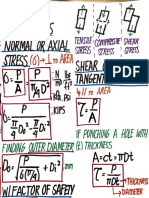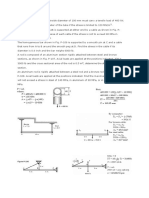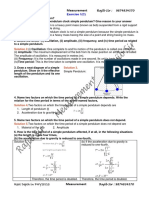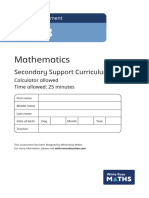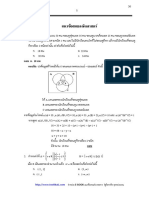100%(1)100% found this document useful (1 vote)
1K viewsHelical Spring
This document contains 15 problems involving computing properties of helical springs such as maximum shearing stress, elongation, number of turns, spring constant, wire diameter, and maximum load. The problems provide information about the material, dimensions, load, and shear stress limit of various springs and ask to calculate associated spring properties. Materials include bronze, steel, and phosphor bronze and specifications like shear modulus are provided for each material.
Uploaded by
Mavrix AgustinCopyright
© © All Rights Reserved
Available Formats
Download as DOCX, PDF, TXT or read online on Scribd
100%(1)100% found this document useful (1 vote)
1K viewsHelical Spring
This document contains 15 problems involving computing properties of helical springs such as maximum shearing stress, elongation, number of turns, spring constant, wire diameter, and maximum load. The problems provide information about the material, dimensions, load, and shear stress limit of various springs and ask to calculate associated spring properties. Materials include bronze, steel, and phosphor bronze and specifications like shear modulus are provided for each material.
Uploaded by
Mavrix AgustinCopyright
© © All Rights Reserved
Available Formats
Download as DOCX, PDF, TXT or read online on Scribd
You are on page 1/ 4
1.
Determine the maximum shearing stress and
elongation in a bronze helical spring composed of
20 turns of 1.0-in.-diameter wire on a mean radius
of 4 in. when the spring is supporting a load of 500
lb. Use G = 6 106 psi.
2. A helical spring is fabricated by wrapping wire
in. in diameter around a forming cylinder 8 in. in
diameter. Compute the number of turns required to
permit an elongation of 4 in. without exceeding a
shearing stress of 18 ksi. Use G = 12 106 psi.
3.Compute the maximum shearing stress developed
in a phosphor bronze spring having mean diameter
of 200 mm and consisting of 24 turns of 20-mmdiameter wire when the spring is stretched 100 mm.
Use G = 42 GPa.
4.A rigid bar, pinned at O, is supported by two
identical springs as shown in Fig. P-348. Each spring
consists of 20 turns of -in-diameter wire having a
mean diameter of 6 in. Determine the maximum
load W that may be supported if the shearing stress
in the springs is limited to 20 ksi.
5. As shown in Fig. P-350, a homogeneous 50-kg
rigid block is suspended by the three springs whose
lower ends were originally at the same level. Each
steel spring has 24 turns of 10-mm-diameter on a
mean diameter of 100 mm, and G = 83 GPa. The
bronze spring has 48 turns of 20-mm-diameter wire
on a mean diameter of 150 mm, and G = 42 GPa.
Compute the maximum shearing stress in each
spring.
6.Determine the maximum shearing stress and
elongation in a helical heavy steel spring composed
of 10 turns of 10-mm-diameter wire on a mean
radius of 50 mm when the spring is supporting a
load of 2 kN. Use G = 83 GPa.
7. Determine the maximum shearing stress and
elongation in a bronze helical spring composed of
15 turns of 1.0-in.-diameter wire on a mean radius
of 5 in. when the spring is supporting a load of 500
lb. Use G = 6 106 psi.
8. A helical light spring has a wire .5 in. in diameter
around a forming cylinder 9 in. in diameter.
Compute the number of turns required to permit an
elongation of 5 in. without exceeding a shearing
stress of 18 ksi. Use G = 12 106 psi.
9. Compute the maximum shearing stress
developed in a phosphor bronze spring having mean
diameter of 250 mm and consisting of 20 turns of
100-mm-diameter wire when the spring is stretched
100 mm. Use G = 42 GPa.
12. Compute for the mean radius of a heavy spring
with a wire diameter of 15mm supporting a load of
300N. Maximum shearing stress is 6 MPa.
13. Determine the maximum shearing stress in a
bronze helical heavy spring composed of 6 turns of .
8 -in.-diameter wire on a mean radius of 7 in. when
the spring is supporting a load of 525 lb.
10. A light spring has a wire 1.5 in. in diameter
around a forming cylinder 10 in. in diameter.
Compute the number of turns required to permit an
elongation of 10 in. without exceeding a shearing
stress of 18 ksi. Use G = 12 106 psi.
14. Compute for the spring constant of a bronze
spring having a mean radius of 131 mm with a wire
diameter of 12 mm and 19 turns supporting a load
of 69N. Use G = 42 GPa.
11. Compute for the diameter of the light spring if
the allowable shearing stress is 5 MPa and having a
mean radius of 150 mm supporting a load of 1.5KN.
15. .Compute for the maximum load that a
phosphor bronze spring can carry having mean
diameter of 324 mm and consisting of 12 turns of
14-mm-diameter wire when the spring is stretched
107 mm. G = 42 GPa.
You might also like
- Unit Title: It's A Slippery Slope!: Project-Based Learning Unit PlanNo ratings yetUnit Title: It's A Slippery Slope!: Project-Based Learning Unit Plan9 pages
- Polytechnic University of The Philippines: ENSC 20043 Statics of Rigid Bodies Quiz 2No ratings yetPolytechnic University of The Philippines: ENSC 20043 Statics of Rigid Bodies Quiz 23 pages
- ABELLA, Edward A. April 16, 2018 10:30-11:30 MWF Engr. Kevin O. ObfanNo ratings yetABELLA, Edward A. April 16, 2018 10:30-11:30 MWF Engr. Kevin O. Obfan6 pages
- Problem Set: Strain and Thermal StressesNo ratings yetProblem Set: Strain and Thermal Stresses5 pages
- Lesson 3 Direction of Lines, Interior and Deflection Angles, Etc.No ratings yetLesson 3 Direction of Lines, Interior and Deflection Angles, Etc.8 pages
- Mechanics of Deformable Bodies M1 Post TestNo ratings yetMechanics of Deformable Bodies M1 Post Test3 pages
- The Cable AE Supports Three Vertical Loads From...No ratings yetThe Cable AE Supports Three Vertical Loads From...3 pages
- Solution To Problem 204 Stress-Strain Diagram - Strength of Materials ReviewNo ratings yetSolution To Problem 204 Stress-Strain Diagram - Strength of Materials Review3 pages
- The Outside Diameter of The Tube If The Stress Is Limited To 120 MN/MNo ratings yetThe Outside Diameter of The Tube If The Stress Is Limited To 120 MN/M19 pages
- Solution To Problem 613 - Double Integration Method - Strength of Materials Review at MATHalinoNo ratings yetSolution To Problem 613 - Double Integration Method - Strength of Materials Review at MATHalino4 pages
- Stress: Normal Stress Shearing Stress Bearing StressNo ratings yetStress: Normal Stress Shearing Stress Bearing Stress23 pages
- Lesson 16 Stress Transformation (Mohr Circle)No ratings yetLesson 16 Stress Transformation (Mohr Circle)4 pages
- Workout No. 3 Poisson'S Ratio, Torsion, Helical Springs, Eccentrically Riveted Connections0% (3)Workout No. 3 Poisson'S Ratio, Torsion, Helical Springs, Eccentrically Riveted Connections3 pages
- Strength of Materials Unit 3 Question Bank: Jansons Institute of TechnologyNo ratings yetStrength of Materials Unit 3 Question Bank: Jansons Institute of Technology3 pages
- Rajasthan Topper Nakul Pareek 2nd Grade Math Teaching Method SampleNo ratings yetRajasthan Topper Nakul Pareek 2nd Grade Math Teaching Method Sample24 pages
- Articles: Real-Time Suggestions, Wherever You WriteNo ratings yetArticles: Real-Time Suggestions, Wherever You Write8 pages
- Design and Intended Use of A Passive Actuation Strategy For A 2019No ratings yetDesign and Intended Use of A Passive Actuation Strategy For A 20196 pages
- Paper - Contribution of LLR To Fundamental Astronomy - Chapront - 2001No ratings yetPaper - Contribution of LLR To Fundamental Astronomy - Chapront - 20016 pages
- Real Depth in PHYSICS Measurement: Solution 1No ratings yetReal Depth in PHYSICS Measurement: Solution 13 pages
- Design of An Air Distribution System For A Multi-Story Office BuildingNo ratings yetDesign of An Air Distribution System For A Multi-Story Office Building54 pages
- Y8 Support Autumn Assessment Calculator 2023No ratings yetY8 Support Autumn Assessment Calculator 20238 pages
- (Said S.E.H. Elnashaie, Parag Garhyan) ConservatioNo ratings yet(Said S.E.H. Elnashaie, Parag Garhyan) Conservatio661 pages
- 1 Analytical Part (3 Percent Grade) : + + + 1 N I: y +1 I 1 N I: y 1 INo ratings yet1 Analytical Part (3 Percent Grade) : + + + 1 N I: y +1 I 1 N I: y 1 I5 pages
- ASME PTC 30-1991 Air Cooled Heat ExchangersNo ratings yetASME PTC 30-1991 Air Cooled Heat Exchangers19 pages
- Traffic Assignment: Urban Transportation Systems PlanningNo ratings yetTraffic Assignment: Urban Transportation Systems Planning29 pages
- Attributable Fractions (As11) : Course: PG Diploma/ MSC EpidemiologyNo ratings yetAttributable Fractions (As11) : Course: PG Diploma/ MSC Epidemiology37 pages
- 11th Maths EM Vol2 Study Materials English Medium PDF DownloadNo ratings yet11th Maths EM Vol2 Study Materials English Medium PDF Download21 pages
- Unit Title: It's A Slippery Slope!: Project-Based Learning Unit PlanUnit Title: It's A Slippery Slope!: Project-Based Learning Unit Plan
- Polytechnic University of The Philippines: ENSC 20043 Statics of Rigid Bodies Quiz 2Polytechnic University of The Philippines: ENSC 20043 Statics of Rigid Bodies Quiz 2
- ABELLA, Edward A. April 16, 2018 10:30-11:30 MWF Engr. Kevin O. ObfanABELLA, Edward A. April 16, 2018 10:30-11:30 MWF Engr. Kevin O. Obfan
- Lesson 3 Direction of Lines, Interior and Deflection Angles, Etc.Lesson 3 Direction of Lines, Interior and Deflection Angles, Etc.
- The Cable AE Supports Three Vertical Loads From...The Cable AE Supports Three Vertical Loads From...
- Solution To Problem 204 Stress-Strain Diagram - Strength of Materials ReviewSolution To Problem 204 Stress-Strain Diagram - Strength of Materials Review
- The Outside Diameter of The Tube If The Stress Is Limited To 120 MN/MThe Outside Diameter of The Tube If The Stress Is Limited To 120 MN/M
- Solution To Problem 613 - Double Integration Method - Strength of Materials Review at MATHalinoSolution To Problem 613 - Double Integration Method - Strength of Materials Review at MATHalino
- Stress: Normal Stress Shearing Stress Bearing StressStress: Normal Stress Shearing Stress Bearing Stress
- Workout No. 3 Poisson'S Ratio, Torsion, Helical Springs, Eccentrically Riveted ConnectionsWorkout No. 3 Poisson'S Ratio, Torsion, Helical Springs, Eccentrically Riveted Connections
- Strength of Materials Unit 3 Question Bank: Jansons Institute of TechnologyStrength of Materials Unit 3 Question Bank: Jansons Institute of Technology
- Rajasthan Topper Nakul Pareek 2nd Grade Math Teaching Method SampleRajasthan Topper Nakul Pareek 2nd Grade Math Teaching Method Sample
- Articles: Real-Time Suggestions, Wherever You WriteArticles: Real-Time Suggestions, Wherever You Write
- Design and Intended Use of A Passive Actuation Strategy For A 2019Design and Intended Use of A Passive Actuation Strategy For A 2019
- Paper - Contribution of LLR To Fundamental Astronomy - Chapront - 2001Paper - Contribution of LLR To Fundamental Astronomy - Chapront - 2001
- Design of An Air Distribution System For A Multi-Story Office BuildingDesign of An Air Distribution System For A Multi-Story Office Building
- (Said S.E.H. Elnashaie, Parag Garhyan) Conservatio(Said S.E.H. Elnashaie, Parag Garhyan) Conservatio
- 1 Analytical Part (3 Percent Grade) : + + + 1 N I: y +1 I 1 N I: y 1 I1 Analytical Part (3 Percent Grade) : + + + 1 N I: y +1 I 1 N I: y 1 I
- Traffic Assignment: Urban Transportation Systems PlanningTraffic Assignment: Urban Transportation Systems Planning
- Attributable Fractions (As11) : Course: PG Diploma/ MSC EpidemiologyAttributable Fractions (As11) : Course: PG Diploma/ MSC Epidemiology
- 11th Maths EM Vol2 Study Materials English Medium PDF Download11th Maths EM Vol2 Study Materials English Medium PDF Download

























































